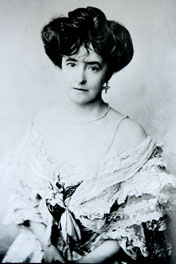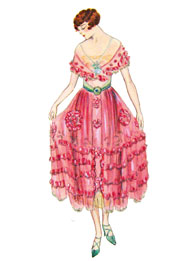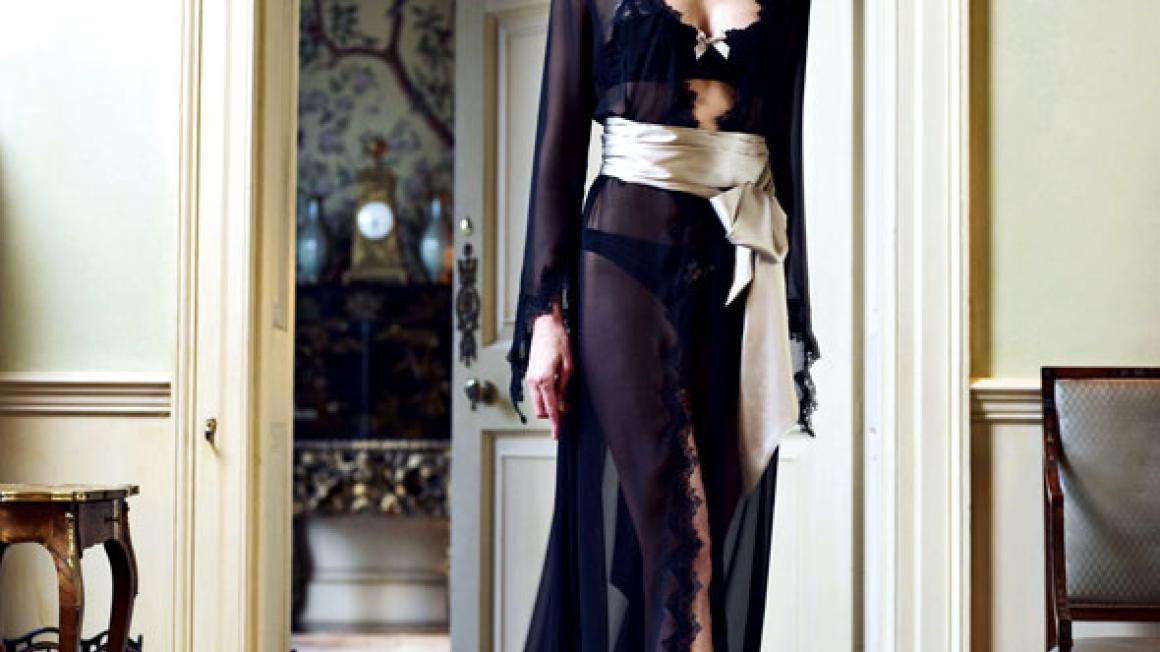They're no ordinary knickers
The enduring image of Lucy, Lady Duff Gordon, is of a privileged aristocrat being rowed to safety in a virtually empty lifeboat as more than 1,500 people perished on the stricken Titanic. Just moments before, Lucy, an internationally renowned couturier, her personal assistant Laura Francatelli, and husband Sir Cosmo Du Gordon, had boarded the captain’s craft as the boat that was heralded as unsinkable hit an iceberg and plunged to the bottom of the ocean in one of the most dramatic maritime disasters in history.
In the century that has followed that fateful evening of 15 April 1912, Sir Cosmo’s name has become synonymous with cowardice. Not only did he board a boat intended for ‘women and children’, but he was said to have bribed the crew not to row back and try to save more lives, for fear that the rescue vessel would capsize.
 Lady Duff Gordon
Lady Duff Gordon
Shortly after the wealthy couple and their assistant joined just two other passengers and seven crew aboard the craft, Sir Cosmo was seen o ering each man £5 – some £300 in today’s money. He has always maintained it was an act of generosity, designed to help the men buy new kit, but when one of them later described the payment as blood money (and Lucy was overheard making flippant remarks about the tragedy at a society function in New York), the Scottish landowner became a social pariah.
Word soon spread that Lucy, scion of one of the first global fashion houses, had remarked glibly to her assistant, ‘There is your beautiful nightdress gone,’ as the cries of the drowning filled the night air. The vessel that rescued them became known as the millionaires’ boat, and when the pair and their assistant were called to give evidence to the British Board of Trade Inquiry into the disaster, their appearance drew the largest crowds of the investigation.
Lucy, accused of trivialising the disaster, was deemed to have given evasive evidence, while her husband insisted he had not bribed the crew. Although both were cleared of any wrongdoing, Sir Cosmo’s reputation never recovered. As one of only 57 male passengers from first class to survive, he was shunned by society and became a virtual recluse, living the remainder of his life at his estate in Aberdeenshire. Lucy, by contrast, threw herself back into her couture business, made New York her home and continued to thrive for more than a decade. Now the designer’s great-great-granddaughter, Camilla Blois, is relaunching her famous relative’s fashion house, Maison Lucile, and once again drawing attention to the family’s controversial past.
‘It has taken me four and a half years to revive the brand,’ says Camilla, 41, explaining that the launch was never intended to coincide with the Titanic anniversary. Growing up in Su olk, she says, ‘We had lots of my grandmother’s sketchbooks and clothes in our house, and my sister and I used to spend hours dressing up in her clothes. The more I delved into her story, the more fascinated I became. She changed women’s fashions. She was all about empowering women with clothes from the inside out.’
 One of Lucy's black gown designs
One of Lucy's black gown designs
Throughout her childhood, the shadow of that fateful night loomed large. ‘No one in my family would ever talk about the Titanic,’ she says. Camilla believes Sir Cosmo’s gift of £5 to each crewman was ‘an act of kindness’ and dismisses some of Lucy’s actions as indications of her ‘eccentric nature’. Asked about Lucy’s flippant comment about her assistant’s nightgown, she replies, ‘In her autobiography she says the mood of the boat was so sombre nobody thought they were going to live. I think she said that to try and lighten the mood, with a bit of black humour.’
Despite Camilla’s hopes that history will look favourably on her notorious forebears, the Duff Gordons will probably remain forever linked with the stricken vessel and their questionable behaviour while being rescued from it. Nevertheless, Camilla, who has a degree in zoology, has worked in marketing, and run a lingerie store in Manchester and an internet gift business, has high hopes for the brand.
‘My long-term dream would be to have Maison Lucile in London, Paris, New York and Chicago, as it was 100 years ago,’ she explains. But to begin with, she has launched a 20-piece collection of handmade silk and chiffon lingerie. Consisting of two lines, the Duchess of Warwick and the Queen of Spain – each named after famous clients of Lady Duff Gordon – the pieces are reminiscent of their originals.
‘The Duchess of Warwick collection is all black and gold, which were her favourite colours. In fact, the Duchess famously had her boudoir – and all her linen – redesigned to match her Lucile lingerie,’ says Camilla. At the height of its fame, Maison Lucile’s impressive client list included the courtesan Mata Hari, Lillie Langtry, Lily Elsie – the actress who became the most photographed woman in the world before Elizabeth Taylor – and Princess Alice. ‘In 1907 she was the richest woman in trade, bar Helena Rubinstein,’ says Camilla.
 Opera cloak
Opera cloak
Yet things could have turned out very differently for the enterprising Lucy, who was not only a divorcée but a single working mother – at a time when both were considered the height of scandal. Born Lucy Sutherland in 1863, she was raised in Canada and the Channel Islands by her grandparents following her father’s death. A disastrous first marriage at 21 to alcoholic womaniser James Wallace ended after six years when he left her for another woman. In a bold move she petitioned for divorce and, with a daughter, Esme, to support, had to take work as a dressmaker in her small London home. Her first client was her sister, Elinor Glyn, the erotic writer and film producer who introduced her to her theatrical friends. As Lucy’s popularity grew, she opened her first store, Maison Lucile, in 1894 in London’s Old Burlington Street. Her designs were viewed by some as rather risqué – and included such daring innovations as low necklines and split skirts.
‘People used to leave her store with their purchases in brown paper bags – some of the lingerie was see-through, which was considered an outrage at the time,’ laughs Camilla.
A feminist long before the soubriquet was coined, Lucy was determined to free women from their restrictive corsets and to do her bit for women’s suffrage. ‘Even though she never joined the movement, one season she designed all her clothes in the suffragettes’ colours so women could show their support subtly without their husbands finding out and becoming angry.’
She was credited with introducing human mannequins and was an early precursor of the catwalk show – she had her ‘girls’ walk up and down in her stores modelling the clothes, to lure women into buying more dresses than they could afford. ‘Lucy used to walk around London and into the Ritz trailed by four or five models dressed in her designs. She invented the “It girl”, and those women all married gentry.’ In 1900, she married Cosmo, her business partner, and the brand expanded to Paris and the US, where her signature style became ‘the personality dress’.
‘She would spend days with clients getting to know them, going for walks and taking tea before designing for them,’ says Camilla. ‘She added individual touches like their favourite handmade flowers so each garment was unique and identified with the owner.’
 A pink gown by Lady Duff Gordon
A pink gown by Lady Duff Gordon
She opened the Rose Room, selling perfume along with clothes, and soon added accessories and cosmetics to her brand – 50 years before Dior did. When she boarded the Titanic on its ill-fated maiden voyage, she took with her three fur coats, seven hats, feather boas, tea gowns, kid gloves, diamonds and pearls with an estimated worth of £250,000 in today’s money.
Despite the notoriety that accompanied her name thereafter, Lucy continued to trade until a landmark court case over the use of the Maison Lucile name bankrupted her. Approaching 60, she had to learn to take buses for the first time and died just 12 years later in Putney, London. Hers was an extraordinary life at a pivotal time in history. Her great-great-granddaughter hopes the time is once again right to revive her iconic brand.
Camilla has remortgaged her home to finance her dream and employed her own mother, Caroline, to help with the stitching. ‘Women will always love beautiful things, even in times of recession, and I think my grandmother would have been thrilled to see Maison Lucile return.’
Lucile: 0845-833 3308, www.lucileandco.com


